Son of John Dempster (1700-1754), second Laird of Dunnichen, and Isabel Ogilvie. Brother of Jean (Jeanie) Dempster and Helen Dempster (d. 1831). Married to Rose Heming (1734-1810) of Caldecott Hall in 1774. At the age of 22 he inherited his father, and became the third Laird of Dunnichen, inheriting a nice fortune at the same time. He died without issue and was inherited by his sister Helen (then Helen Burrington-Dempster).
Dempster was educated at the grammar school of Dundee and at the Universities of St. Andrews and Edinburgh. He was admitted to the Faculty of Advocates in 1755. At about the same time he became a member of the Select Society, the major literary and intellectual society of Edinburgh, of which he was to become a director, and to which Boswell was admitted a few years later. In 1762 he also joined (possibly co-founded) The Poker Club, which had just been founded by his friend Adam Ferguson and other members of the Select Society.1 In 1761 Dempster was elected Member of Parliament for Fife and Forfar Burghs, a seat which he held until his retirement in 1790. In 1765 he was appointed Secretary to the Order of the Thistle,2 succeeding Henry Erskine, and in 1769 he was elected a Director of the East India Company. In 1780 he was Provost of St. Andrews. After he left parliament in 1790 he dedicated much of his time to promoting and reforming fishery and agriculture in Scotland, as well as improving the living conditions of his tenants.
Dempster was much inspired by the scepticism and liberalism of the Scottish enlightenment (esp. David Hume), and he was probably one of the most progressive Members of Parliament of the time. He eventually gained the nickname "Honest George". Although originally intended to be a sarcastic sobriquet (as he had to buy his voters, as was the custom at the time), it seemed later on to be a correct description of Dempster who became known as an "independently minded, incorruptible and moderately radical MP".
He was a lifelong friend of philosopher Adam Ferguson and clergyman Alexander Carlyle.
Following his death in 1818, Sir Walter Scott sent the following epitaph, supposedly written sometime earlier by Dempster himself, to John Wilson Croker: (Boswelliana, p. 34)
Pray for the soul of deceased George Dempster,
In his youth a great fool, in his old age a gamester;
What you're to know, on this tomb you shall see,
Life's thread he let go when just ninety-three.
So sound was his bottom, his acquaintance all wonder'd
How old Nick had got him till he lived out the hundred.
To his money concerns he paid little attention,
First selling his land, then pawning his pension;
But his precious time he much better did manage,
To the end of his life from his earliest nonage,
He divided his hours into two equal parts,
And spent one half in sleeping, the other at cartes.
Dempster and Boswell probably met in the Select Society, a literary social club of Edinburgh to which Boswell was admitted ca. 1760. In 1761 Dempster wrote Boswell a letter of introduction to Andrew Erskine, believing that the two of them would get on fine - just two years later, Erskine and Boswell published their already extensive correspondence. On November 3, 1763, Boswell described Dempster as "a most agreeable well-bred man, sensible and clever, gentle and amiable, quite a gentleman".
Dempster was one of Boswell's closest friends in London 1762-63, and he appears frequently in Boswell's London Journal.
Shortly after Boswell's departure for Holland, Dempster followed, rushing from Paris to Bruxelles (62 leagues in 30 hours) after having received a letter from a much depressed Boswell. Not having expected such speed on Dempster's part, Boswell had left Bruxelles for a tour with John Morgan shortly before Dempster's arrival and only arrived back after Dempster had to return to Scotland.
Although his sense of humour seems to have been a bit too harsh for Boswell at times, for example, when, on February 15, 1763, Dempster and Andrew Erskine presented Boswell with a hoax letter supposedly written by David Hume. A few weeks later, however, Boswell had forgiven all and described Dempster as "a most agreeable man: has fine sense, sweet dispositions, and the true manners of a gentleman."3
Dempster co-authored, with Boswell and Andrew Erskine, Critical Strictures on the New Tragedy of 'Elvira', written by Mr. David Malloch in 1763.
According to John Evans in his biography of Dempster:
Strangely, Dempster and Boswell, who were not at all alike, were to get along famously during the first three or four years of the MP’s life in London, perhaps too much so. Dempster’s delight in jests and a life-long penchant for all manner of amusement and nonsense certainly lent support to their relationship. The friendship understandably faded when Dempster found less time in which to indulge his friend’s whims, but it only came to an end when Boswell died more than thirty years later.4
Evans further noted that "Boswell left Dempster a gold mourning ring at his death – a token confirming that their friendship, though interrupted, was never quite broken."5
What is probably the most famous painting of James Boswell as a young man was painted in 1765 in Rome by George Willison, Dempster's nephew, who had been sent there to study art, sponsored by Dempster.
The authoritative biography on Dempster is John Evans' The Gentleman Usher: The Life and Times of George Dempster (1732-1818) (2004).
